You can choose from a variety of materials for your new doors, including fiberglass, metal, wood, and uPVC (unplasticized polyvinyl chloride). Regarding cost, look, weather resistance, durability, security, and insulation, each material has pros and cons of its own. When it comes to external doors, uPVC has become the most widely used material. This is a detailed comparison of uPVC doors with alternative materials.
Post your Requirement
The table that follows summarizes details regarding UPVC doors in India, including cost:
| Term | Definition |
| UPVC doors | UPVC (Unplasticized Polyvinyl Chloride) doors are doors made from a type of plastic known for its durability, low maintenance, and energy efficiency. UPVC doors are popular for their resistance to weathering, corrosion, and termites. |
| UPVC doors in India | Refers to UPVC doors specifically available in the Indian market. These doors are designed and manufactured to suit the climate, preferences, and standards prevalent in India. |
| UPVC doors price | The cost associated with purchasing UPVC doors. Prices may vary based on factors such as size, design, brand, and additional features. |
Let us now go through the reasons stated below as to why one must choose uPVC Doors over wood,metal or fibreglass:
1. Appearance:
In terms of appearance, wooden doors are often considered the most aesthetically pleasing, featuring beautiful, natural wood grains and warm colors. The downside is that wood doors require extensive maintenance to keep protected from the elements. Over time the finish will fade, crack, and peel, revealing the bare wood underneath.
Metal doors are very utilitarian in style, often featuring simple, industrial designs without much ornamentation. Fiberglass doors can closely mimic the look of wood with fake wood grain patterns. The colors and patterns are imprinted rather than natural, however.
uPVC doors offer the greatest versatility when it comes to aesthetics. uPVC takes paints and stains well, so you can easily change their color. uPVC door styles are also widely available, ranging from classic to modern, in solid colors or attractive wood grain patterns. This allows a uPVC door to mimic wood, or achieve virtually any color or finish desired. A key advantage is that the color and patterns go all the way through the uPVC material, rather than just being surface deep like fiberglass.
2. Durability:
Wood doors are quite prone to damage – impacts will dent wood and the bottoms will eventually rot from moisture exposure. Fiberglass doors are more rigid and resilient than wood, but the gel coat surface can become chipped and dinged over time.
Metal doors offer the greatest durability and resistance to physical impacts, but they can still become dented by forceful blunt force. Metal is also prone to rusting and corrosion, especially on the bottom edge and around holes drilled for hardware or accessories. Maintaining the protective paint layer is essential for metal doors.
uPVC doors are highly durable and able to withstand a beating. Impacts cause little damage thanks to the flexible, resin nature of uPVC, which springs back into shape. uPVC won’t rot or corrode, and it maintains its integrity even with heavy use over many years. Of all the door materials, uPVC withstands wear and tear the best. The very durable surface requires little maintenance beyond the occasional cleaning.
3. Weather Resistance:
Wood doors and metal doors provide little protection against the elements on their own. Over time sun, wind, rain snow and temperature shifts will damage wood and metal. Special weatherstripping and protective finishes must be maintained. Fiberglass doors are more rigid and impenetrable than wood, but prolonged sun exposure will still fade the gel coat surface.
uPVC doors inherently resist weather influences better than wood, metal or fiberglass. The uPVC material itself is waterproof and provides excellent insulation against temperature changes. Multi-chambered internal structures also boost energy efficiency. Even intense sun and heat cause little material degradation thanks to built-in UV stabilizers. With their dense, impenetrable material, uPVC doors function exceptionally well through seasons and all types of inclement weather.
4. Security:
Wood doors and fiberglass doors have a soft inner foam or particle board core enclosed by a thin hard shell, making them somewhat vulnerable to forceful impacts and prying. Metal doors are more secure thanks to their rigidity and strength, but security still relies heavily on the quality of locks used.
The solid, dense material construction of a uPVC door makes it extremely difficult to break down by force. uPVC won’t crack or shatter like wood or fiberglass under blunt force. Locks and deadbolts are also more securely anchored into the reinforced frames. For maximum home security, uPVC doors offer comparable protection against intruders as metal doors. The addition of multiple point locks for uPVC French doors also minimizes the risk of forced entry.
5. Insulation & Energy Efficiency:
Poorly insulated exterior doors lead to energy loss and higher heating/cooling bills. Metal doors feel cold to the touch and readily conduct heat or cold thanks to their high thermal conductivity. Wood also does not provide very good insulation on its own. Fiberglass offers slightly better insulation than wood doors, but efficiency can vary greatly depending on door thickness and foam density.
uPVC doors are the top choice when it comes to home insulation. The innate insulating properties of uPVC keeps interior warmth in and outside temperatures out thanks to a low U-value, typically between 1.5 to 2. This is several times more efficient than a wood or metal door and better than most standard fiberglass doors. Multi-chambered interior voids further prevent heat transfer for incredible energy savings. By installing a uPVC door, homeowners can tangibly reduce heating and cooling expenditures.
6. Cost:
Wood doors with intricate carvings or inserts tend to be among the most expensive exterior door options. However, lower grade wood doors with simple designs are also available at moderate price points. Metal doors also range widely in pricing depending on level of ornamentation and accessories. Basic styles start lower but custom designs run quite high. Most standard fiberglass doors cost slightly less than a mid-range wood door.
Well-constructed uPVC doors start out very economical relative to wood or fiberglass. uPVC lacks elaborate frills which helps keeps costs down. Intricately designed uPVC doors with custom colors, wood grain patterns and decorative window inserts can still cost more, but remain lower in price than comparable designs from other materials. Thanks to their durability and weather-resistance, a quality uPVC door also avoids the continual upkeep expenses associated with wood and metal doors over their lifespan.
7. Installation & Maintenance:
Wood and metal doors typically require professional installation given their heavy weight and need for perfect alignment, sealing, weatherstripping and hardware fittings. Fiberglass doors are a bit simpler for DIYers to handle but still benefit from an expert setup. All of these door materials demand regular maintenance every 1-2 years – sanding and re-varnishing wood, repainting metal, re-applying protective gel coat sealant to fiberglass.
Standard size uPVC doors are designed as do-it-yourself installations. With precise factory measurements and pre-drilled fitting holes, uPVC doors can slip directly into an existing doorway opening without difficult adjustments. The lightweight material enables easy maneuvering as well. Little maintenance is needed thanks to uPVC’s inherent durability and weather resistance. An occasional wiping with a damp cloth keeps the surface clean. With quick self-installation and almost no annual upkeep requirements, uPVC doors are extremely simple and convenient to live with.
8. Environmental Impact:
The sustainability of each type of exterior door material should also be considered. Wood doors must use lumber harvested from trees in forests. Over-logging threatens many delicate ecosystems. Metal door production utilizes energy-intensive mining and refining processes that generate pollution. The fiberglass used in composite doors also carries some environmental impacts from raw material extraction and manufacturing.
In contrast, uPVC doors take environmental friendliness to the next level through sustainable, recycled materials and ecologically clean production methods. The uPVC consists primarily of salt and natural gas rather than limited resources. With uPVC doors taking over 70% of the UK replacement door market based on homeowner preferences, this material keeps a remarkable quantity of wood, metal and fiberglass out of landfills or the recycling stream. uPVC doors represent the future of eco-conscious construction around the world.
Conclusion
uPVC doors match or surpass all other exterior door materials across the board. For aesthetics, uPVC doors now replicate beautiful wood grains or achieve any desired color through paints and stains that bond reliably with the surface. The dense, inflexible physical composition makes uPVC doors highly resistant to damage from impacts and daily wear-and-tear. uPVC also inherently insulates against extreme temperatures, weather events and UV exposure thanks to integrated stabilizers that prevent material degradation. Locks and multi-point mechanisms on uPVC doors deliver robust security.
Easy DIY installation, sustained performance for decades, and virtually no maintenance needed make uPVC doors a convenience that homeowners appreciate. Affordable pricing even for customized designs keeps costs reasonable for most budgets. Environmentally speaking, uPVC doors utilize recycled materials and cleaner production methods compared to wood, metal and fiberglass alternatives. With so many clear practical advantages across the board, uPVC doors represent the smartest choice for exterior home doors moving forward.


















Post A Comment